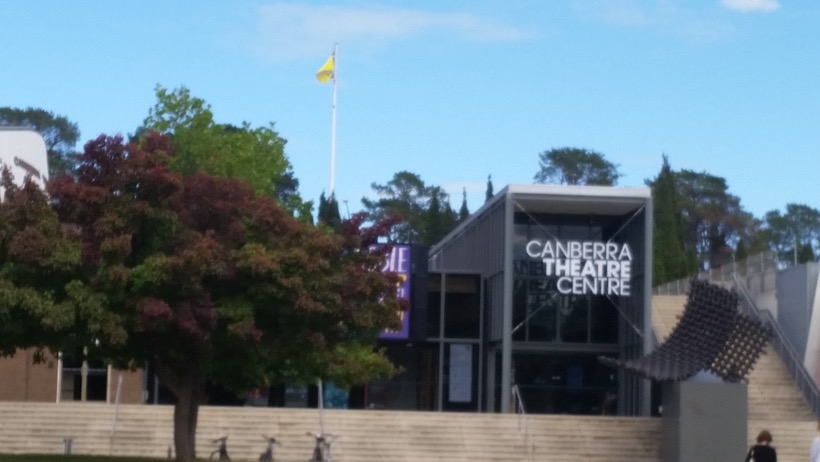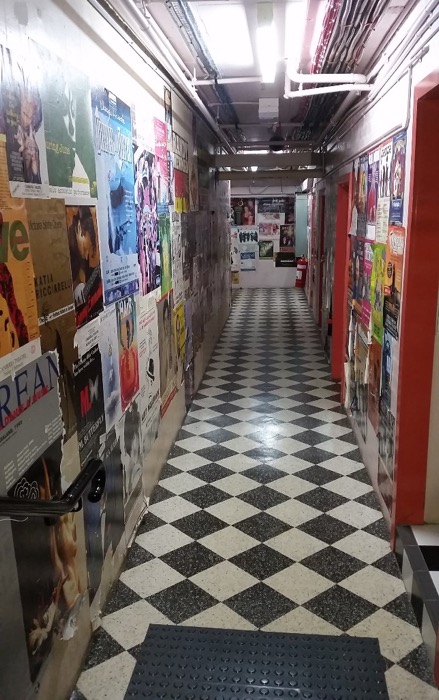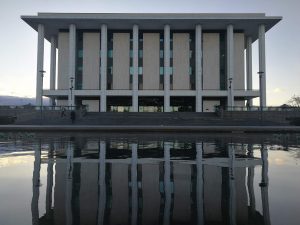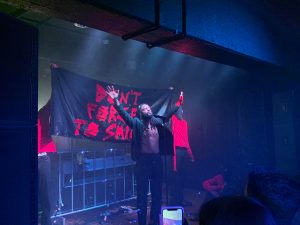The Hidden Talent
By Kayla Brock
Lights flicker as people in all black rush across the floor scurrying like mice to their positions. They have a single purpose to fulfill. The stage is their stomping ground and the equipment is their tool. The lights stop flashing and the bright sound of an introduction begin to fill the House. Curtains flap as the crew pull them open and the talking in the audience comes to a halt.
“A good technician is a technician never noticed,” says Technical Director Rowan Cutler. Rowan had no experience as a technical director when he first started twelve years ago, but now he is the head of all four technical departments: audio, electric, fly man, and stage door.
Actors, Directors, Musicians, Make-Up Artists, Technicians. These are the people who took a step back from the stage and have provided a wave of support and dedication to the arts. The CTC, Canberra Theatre Centre, was the start of it all for theatre in Australia, but the people who provided and helped create that environment are pushed behind the curtains and it’s time for them to take a bow
Rowan’s statement lays the basis of a life of a crew member, but the crew member has more hidden talents then just being unseen.
 As a Theatre Technician, you are responsible for ensuring that lighting, sound, and props are ready for the incoming performers requiring long hours for relatively little money. It is typical for a technician to work between fourteen and eighteen hours a day for weeks on end. The days start with the incoming trucks at eight in the morning, followed by an array of crew work, such as plotting, rehearsal, sound checks, and light checks followed by the performance, a complete tear down, and a wave goodbye. Most times they only get a full 24 hours to put up and tear down a show, as touring company’s may only use the space for a day. Canberra Theatre is a proscenium arch theatre seating 1,244 patrons in its main theatre, but there is one thing it is lacking; funding
As a Theatre Technician, you are responsible for ensuring that lighting, sound, and props are ready for the incoming performers requiring long hours for relatively little money. It is typical for a technician to work between fourteen and eighteen hours a day for weeks on end. The days start with the incoming trucks at eight in the morning, followed by an array of crew work, such as plotting, rehearsal, sound checks, and light checks followed by the performance, a complete tear down, and a wave goodbye. Most times they only get a full 24 hours to put up and tear down a show, as touring company’s may only use the space for a day. Canberra Theatre is a proscenium arch theatre seating 1,244 patrons in its main theatre, but there is one thing it is lacking; funding
The Sydney Opera House attracts more than 8.2 million visitors a year. People go for the architecture and performances, but what they are missing out on is the rich history and treasure of the first performing arts centre in Australia. The Canberra Theatre Centre has long been a centre for the Australian Territory and capital of Australia. The CTC stands proud as the first government initiated performing arts center in Australia, dating back to 1965, (outdating the Sydney Opera House) and its reputation continues to build as a bold brand for incoming tours and performing companies. The centre is just a receiving house, which means that they do not put on any performances of their own, and instead rent out the space to touring companies and provide in house support.
As a theatre, the CTC is restricted by budget from the ACT (Australian Capital Territory) government. With only five permanent staff technicians, they are required to bring in ‘casuals’ to help them when bigger companies come into town. “We aren’t considered to be equal to other state art venues in Australia,” says Rowan.
Due to the population of Canberra and the restricted size of the venue they are constantly struggling to compete. “It’s all about the money,” says Rowan when having to bid for tours to make a tour stop in the capital territory. However, due to restricted schedules they are forced to drop shows. Money earned from the box office makes up 80 percent of their income, while 20 percent of it is from the government under established legislation for the Cultural Facility Cooperation.
“In the United States you have major sponsors, but we don’t have that here in Canberra,” says Tony Martin, member of the education programs. “It is necessary for us to specify the amount we need three to five years ahead. It is icing on the cake if we get more money.” Even the stage itself is strategic in creating more revenue as the theatre has an extended part of the stage where they can place an orchestra seated below the audience. Seating a full orchestra comes at the cost of losing space for seats and a loss in ticket sales. Sometimes competition can become vicious. “We want this show and we will screw other people to get it,” says Rowan. Business is just business and it seems like at certain times there is a desperate need for it.
“People don’t understand the hours and time that go into this theatre. It can take the crew until two or three in the morning to work on a show. It’s not uncommon for my crew to see the sun come up and I have to represent them,” says Rowan.
How common it is to admire the stage or set, but never truly acknowledge the ones who built it and spent hours making sure a performance was to its highest quality. The theatre itself is constantly being expanded. The CTC holds three different performing centers: the Main Theatre, the Playhouse, and the Courtyard. The underlying of the theatre itself looks as if it has been preserved from the 1960s and most of the structure of the theatre is original.
 Coloured tiling runs along the floor in the dressing room and posters of past shows, such as the Australian Ballet Company, lay plastered on the wall with some looking freshly put up and others halfway from falling onto the floor of the backstage area. While understanding a day as a crew member, it became clear that the job was all about maintenance.
Coloured tiling runs along the floor in the dressing room and posters of past shows, such as the Australian Ballet Company, lay plastered on the wall with some looking freshly put up and others halfway from falling onto the floor of the backstage area. While understanding a day as a crew member, it became clear that the job was all about maintenance.
A group of men stood on the stage and the bristles of heavy brushes swept across the floor while others stood with crossed arms, looking up at the stage lights. It was nine in the morning and there were about a dozen or so crew members in blacks. Black clothes and black shoes rummaging on the stage preparing for the start of “The Little Mermaid” that was going to be showcased in April. One member stood atop a sky high ladder with only one other member at its base. His face shone against the lights and the outline of a strap laid against his head.
Small monitors are placed in most of the rooms. These monitors give an opportunity for those not on stage to watch the show while they wait for their cue, and connect with their fellow actors on stage. Past the dressing room I noticed a mark on the wall. As I got closer it was bright pink and red in colour. Kissing marks: the kind you make on your lover, or mother when you are wearing your finest lipstick, were placed against the wall off of the dressing room. A little secret corner and sanctuary for the actors to make their mark on their time there. Making their experience stand still.
Sitting down with Tony, I realise that the people who work here are dedicated to what they do. Since 1978, Tony has put his hard work in providing children in schools the opportunity to learn about the performing arts. Back when he started he asked an important question to his colleague, “Why is this theatre (CTC) the only one in Australia without an education program?”
In 2012, only 33 percent of American adults attended one of the following art activities—classical music, jazz, opera, theatre, ballet, or made visits to an art museum or gallery. This number was down by 39 percent within the past decade, according to National Endowment for the Arts report. Ever since then he has been providing kids with opportunities to intern and work in the arts, and providing teachers a way to bring arts in their classrooms.
Back when he started there were about 65,000 people living in Canberra and now roughly 300,000 enjoy the intricate Australian Capitol. The CTC lives in the -‘grey zone;’- an institution that sits between the small performing arts venue, and the big dogs such as the Queensland Performing Arts Centre in Brisbane or the Victoria Opera House in Melbourne. Despite its smaller size, the CTC reaches out to those looking for a foot in the door. Maybe even because of its size it’s able to take part in the community more than most. Not only does the CTC push to support performing art companies, but they also provide educational programs for those itching for a start in the arts world.
Workshop and lesson plans for teachers help to reiterate performing arts into schools. “It touches lives all the way through which theatre does,” Tori Cordova, Education Officer says when describing the CTC programs. Monthly, the theatre brings in actors to primary and secondary schools where the actors teach students about the shows that are being put on in the theatre. The students also get a chance to learn what it takes to get a show up and running. Providing these programs gives great incite to kids on what can be argued a ‘dying art.’
“Our main goal is to sell tickets,” says Tony, “and my job is to add value to those tickets.” Bringing value through education and value to the shows that are produced are the things that pull people into working behind the scenes. As Rowan says, “The theatre steals your soul, once you are here most people don’t leave.”
Tony is a prime example of the person whose soul was stolen. A person that helps and educates the aspiring actors and leaders in the industry. “When we provide you with something that challenges you, then we have succeeded. Providing entertainment and turning it into a cultural experience is something you will remember, otherwise you might as well sit at home,” he says as he leans back against the couch and looks on at me as I furiously try to write all that he has said.
“I’m not somebody who wants to be commended or famous. I’m here because I refuse to retire. I’m almost 70; I don’t have to be here. I’m here because I want to be.” Theatre is not a pastime for people like Tony, it is their joy, passion, and career. Even though his desire may not be to become an actor himself, Tony puts value in his lifestyle and the lives that he touches.
The centre bellows with the thunder of hands coming together. Whistles and shouts pour from the back of the House all the way to the front where the content men and women grab hands to take a bow. The invisible ones look on with mics wrapped around their waist and ears.
The Directors, Musicians, Make-Up Artists, and Technicians. They all have one thing in common, they love what they do and they don’t need to get recognised to feel successful. The Canberra Theatre Centre is more than just a supporting performance house, it envisions the culture of the capital city and the heart of the stage.




Be the first to comment!